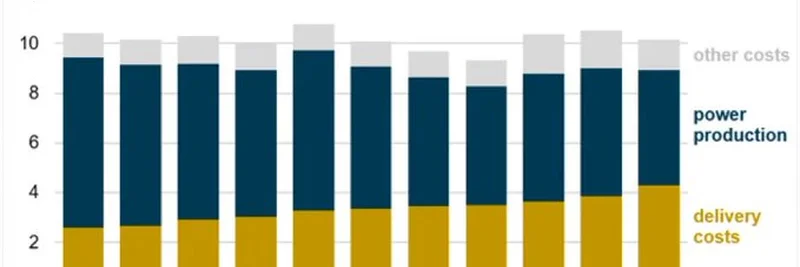Hey there, meme enthusiasts and blockchain pros! Today, we’re diving into a fascinating thread from shek_dev on X that’s got everyone talking about energy distribution and the wild world of costs. As someone who’s been around the block (or should I say blockchain?) as a former CoinDesk editor-in-chief, I’m excited to break this down for you in a way that’s easy to digest—while sprinkling in some SEO magic for good measure.
The Shocking Truth About Energy Costs
The thread kicks off with a mind-blowing chart from the U.S. Energy Information Administration (EIA). It shows how major U.S. utilities have been spending their money from 2010 to 2020, broken down into three categories: power production, delivery costs, and other costs. What’s crazy? The cost to deliver energy over wires is pretty much the same as the cost to generate it! Back in 2010, power production took up about 6-8 cents per kilowatt-hour, while delivery hovered around 4-6 cents. Fast forward to 2020, and the gap has narrowed even more, with delivery costs climbing to match production.
Shek points out something even wilder: more money is being poured into producing energy than delivering it. This flip-flop has sparked a big question—why aren’t we rethinking how we move energy around? It’s like spending more on baking the cake than delivering it to the party!
Batteries to the Rescue?
The conversation doesn’t stop there. Shek follows up with another chart showing how the price of lithium-ion batteries has dropped by a whopping 97% since 1992. Imagine paying $7,500 for a kilowatt-hour of storage back then, and now it’s down to just $181! This steep decline, driven by a 19% price drop every time capacity doubles, opens up some cool possibilities.
So, what’s the big idea? How about storing energy in batteries and trucking it where it’s needed? Think of it like Amazon’s AWS Snowball but for energy—portable power packs rolling into towns. Shek even tosses out the concept of an “AWS Snowball for energy,” which could revolutionize how we handle energy distribution, especially with companies like BASE Power pushing the boundaries of the electric era.
Why This Matters for Blockchain and Memes
Okay, you might be wondering, “What does this have to do with meme tokens or blockchain?” A lot, actually! Energy is the backbone of the tech we love. Mining cryptocurrencies and running decentralized apps (dApps) guzzle power, and as energy costs shift, so do the economics of blockchain. Cheaper storage and innovative distribution could mean greener, more efficient meme token projects. Plus, who wouldn’t love a meme coin powered by a solar-charged battery truck?
The Takeaway
This X thread is a goldmine of ideas, blending data-driven insights with forward-thinking solutions. From the surprising balance of production and delivery costs to the plummeting price of battery storage, it’s clear we’re on the cusp of an energy revolution. Whether it’s trucks hauling power or new companies like BASE Power leading the charge, the future looks electrifying—pun intended!
What do you think? Could battery-powered energy transport be the next big thing? Drop your thoughts in the comments, and let’s keep the conversation buzzing. For more juicy insights, check out meme-insider.com and level up your blockchain game!



